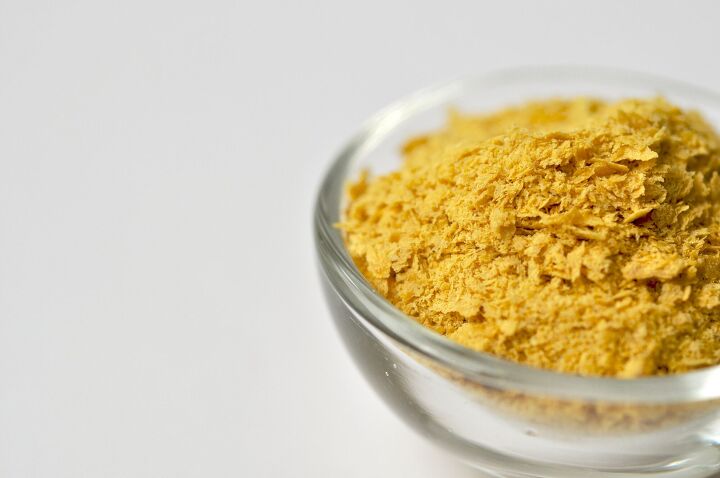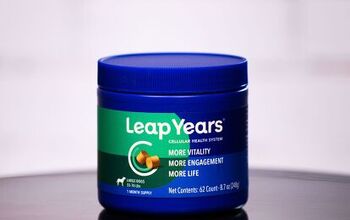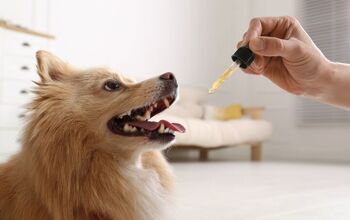Can Cats and Dogs Eat Nutritional Yeast?

Nutritional yeast is popular, especially amongst vegans, for its yummy, cheesy flavor and multitude of nutrients, from protein and potassium to B vitamins and fiber. But is it one of the human foods that cats and dogs can eat? Check out the information below to learn more about nutritional yeast and if it’s safe for your furry friend.
Note: If you’re planning on giving this to your pet, it’s imperative that you purchase the right product. Nutritional yeast is not brewer’s yeast, nor is it the active yeast or instant yeast that rises and is used to bake bread.
Can Dogs Eat Nutritional Yeast?
Yes, you can give nutritional yeast to your dog. If he likes the flavor, you might consider adding some to his food as a little treat so he can derive all of the benefits of the nutrients it contains.
Nutritional yeast can also be used to entice a picky dog to eat, or to simply make a meal more flavorful. Your dog might become more interested in his food if he smells the nutritional yeast on top, and this might entice him to dig in – really helpful if you’ve been struggling to get your pooch to eat enough food every day.
If you think that your dog would benefit from nutritional yeast and your veterinarian has told you it’s safe, it may be worth giving it a try. Your vet might recommend starting with very small amounts, such as ½ teaspoon per day. But, like any other food, not all dogs will like it, so you have to see if your pooch will be a fan or not.
Things to Consider Before Giving Your Dog Nutritional Yeast
As mentioned above, it’s important to buy nutritional yeast specifically, so make sure you don’t get it confused with other types of yeast. Yeast that rises is dangerous and harmful to dogs and should never be fed to them.
Also, when shopping for this food, look for high-quality options without any added ingredients that might be harmful to dogs. Stick with reputable brands that offer pure nutritional yeast.
It’s always wise to consult your veterinarian before giving your dog a new food or supplement, just to be sure it’s safe and appropriate for your pet. Nutritional yeast might not be right for your dog if he has been diagnosed with certain medical conditions or is taking certain medications or supplements. Your vet can also tell you how much to feed your dog based on your pet’s unique needs.
When feeding your dog nutritional yeast for the first time, keep an eye out for allergic reactions or digestive problems. If symptoms occur, let your veterinarian know and stop giving your dog this food.
Can Cats Eat Nutritional Yeast?
Yes, cats can eat nutritional yeast. It could provide a nice little boost of nutrition with its energizing vitamins, and it’s a complete protein, so it might benefit your pet’s health in various ways. You can use it as a treat or add it to your kitty’s meal.
If your cat likes the flavor of nutritional yeast, it may even encourage her to eat more. So, if you have a fussy feline, adding a small amount of nutritional yeast to her dish might be a good way to get her interested in the meal you served up.
As is the case with dogs, start with very small amounts of nutritional yeast when introducing it to your feline. See if she likes it and if it’s worth incorporating it into her meals. Discuss dosage with your vet, as they know your feline’s needs best. As an example, a vet might recommend starting with ¼ teaspoon per day.
Things to Consider Before Giving Your Cat Nutritional Yeast
This can’t be stressed enough: purchase only the highest quality, pure nutritional yeast from trustworthy brands. Don’t confuse this with other types of yeast, such as rising yeast that’s toxic to cats and should be kept away from them. And avoid nutritional yeast that contains ingredients that might be harmful.
Also, don’t overdo it when it comes to adding nutritional yeast to your cat’s diet. Give only very small amounts, particularly when introducing this food, and keep an eye out for allergic reactions or digestive upset.
Consulting your veterinarian before giving your cat this food is wise, especially if your pet is taking medications or supplements or has a medical condition. Your vet can provide guidance on whether or not this food is appropriate for your cat, how much you should give her, and which brands to purchase.
Bear in mind that nutritional yeast contains phosphorus, which may be harmful to cats in high amounts. And if your kitty has certain medical conditions, such as kidney disease, you might need to restrict phosphorus in her diet. Your cat is already getting phosphorus from the food she eats daily, and you don’t want to risk giving her too much by adding the wrong amount of nutritional yeast to the mix, so discussing this with your vet is wise.
Be Sure to Buy the Right Product When Giving a Dog or Cat Nutritional Yeast
A good option to look into is Bragg Nutritional Yeast. Its ingredients are only dried yeast and B vitamins, and it doesn’t contain any artificial colors or flavors. Plus, it’s available in multiple sizes, it’s non-GMO, and both the humans and pets in your household can enjoy it.
Bottom line: cats and dogs can eat nutritional yeast. When given in the right amounts, it may be beneficial to a pet’s overall health. But talking to your veterinarian first is the best way to go, even when it comes to something as simple as adding a bit of nutritional yeast to your pet’s diet. Your vet can tell you if it’s really a good idea, and can tell you how often you should give your pet nutritional yeast and how much you should give. Plus, they can direct you to the right nutritional yeast options that are available so you can be sure you’re giving your dog or cat a safe and beneficial treat.

Lisa Selvaggio is a freelance writer and editor, and our resident cats-pert, with certifications in pet nutrition and pet first aid. She enjoys producing content that helps people understand animals better so they can give their pets a safe and happy home.
More by Lisa Selvaggio
























